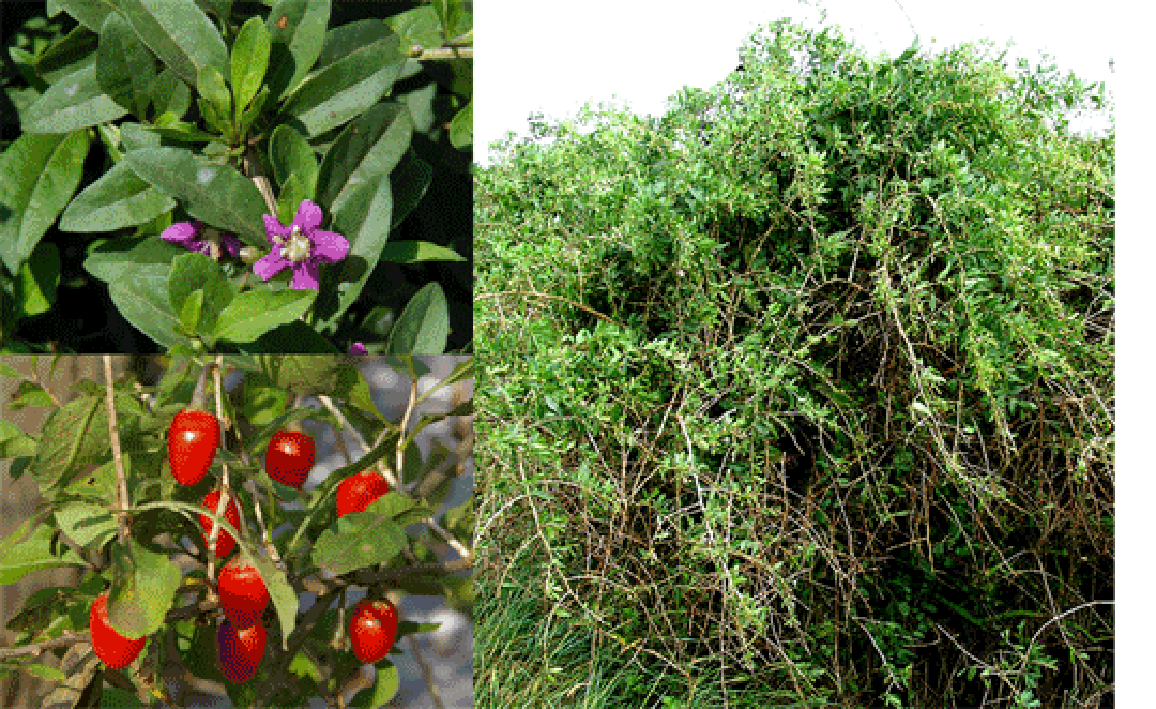 Chinese boxthorn
(wolfberry)
Lycium
barbarum whole
plant, leaves,
flowers and fruit..
Chinese boxthorn
(wolfberry)
Lycium
barbarum whole
plant, leaves,
flowers and fruit..
Welcome to the summary page for FabulousFusionFood's Herb guide to Chinese Boxthorn Leaves along with all the Chinese Boxthorn Leaves containing recipes presented on this site, with 0 recipes in total.
e This is a continuation of an entire series of pages that will, I hope, allow my visitors to better navigate this site. As well as displaying recipes by name, country and region of origin I am now planning a whole series of pages where recipes can be located by meal type and main ingredient. This page gives a listing of all the Cornish recipes added to this site.
These recipes, all contain Chinese Boxthorn Leaves as a major herb flavouring.
Chinese Boxthorn Leaves, Lycium barbarum (also known as Goji Beery Leaf, Wolfberry Leaf) are the leaves of Lycium barbarum or Lycium chinense, species of boxthorn in the family Solanaceae (which also includes the potato, tomato, eggplant, and tobacco). Although its original habitat is obscure (probably southeastern Europe to southwest Asia), wolfberry species are now grown around the world, including in China. Wolfberry species are deciduous woody perennial plants, growing 1–3 m high. Wolfberry leaves form on the shoot either in an alternating arrangement or in bundles of up to 3, each having a shape that is either lanceolate (as it is shaped like a spearhead longer than it is wide) or ovate (egg-like). One to 3 flowers (picture above) occur on stems 1–2 cm in length. 'Wolfberry' is an English translation of gǒuqǐ the plan't Chinese name. In the English-speaking world, 'goji berry' has, in recent years been used as a synonym for Wolfberry.
In China and Japan a tonic tea is made from the leaves. The young, soft, leaves are typically used as a herb, flavouring soups and salads (though they are sometimes cooked as a vegetable). The leaves themselves have a pleasant taste, somewhat reminiscent or watercress, but with a hint of peppermint. They do, however, grow bitter when hold and are sometimes blanched before use. Like many herbs, Chinese boxthorn leaves loose their flavour if over cooked and should be added to a dish no more than 3 or 4 minutes before serving (unless you plant to serve as a vegetable). They are widely used to flavour Chinese soups (particularly those containing pork or liver) and are also used in Vietnamese soups. They are also useful for flavouring dishes containing wild greens. In fusion cooking they can be paired with fruit in fruit soups and fruit-based desserts.
If growing Chinese boxthorn in your own garden for leaf production, you should coppice heavily. Cut almost down to the ground in winter to encourage the growth of new shoots in the spring. Pick only a few branches from a single plant. You can also plant cuttings or the tops of branches used for their leaves in your garden as these will root readily and give you new plants.
e This is a continuation of an entire series of pages that will, I hope, allow my visitors to better navigate this site. As well as displaying recipes by name, country and region of origin I am now planning a whole series of pages where recipes can be located by meal type and main ingredient. This page gives a listing of all the Cornish recipes added to this site.
These recipes, all contain Chinese Boxthorn Leaves as a major herb flavouring.
Chinese Boxthorn Leaves, Lycium barbarum (also known as Goji Beery Leaf, Wolfberry Leaf) are the leaves of Lycium barbarum or Lycium chinense, species of boxthorn in the family Solanaceae (which also includes the potato, tomato, eggplant, and tobacco). Although its original habitat is obscure (probably southeastern Europe to southwest Asia), wolfberry species are now grown around the world, including in China. Wolfberry species are deciduous woody perennial plants, growing 1–3 m high. Wolfberry leaves form on the shoot either in an alternating arrangement or in bundles of up to 3, each having a shape that is either lanceolate (as it is shaped like a spearhead longer than it is wide) or ovate (egg-like). One to 3 flowers (picture above) occur on stems 1–2 cm in length. 'Wolfberry' is an English translation of gǒuqǐ the plan't Chinese name. In the English-speaking world, 'goji berry' has, in recent years been used as a synonym for Wolfberry.
In China and Japan a tonic tea is made from the leaves. The young, soft, leaves are typically used as a herb, flavouring soups and salads (though they are sometimes cooked as a vegetable). The leaves themselves have a pleasant taste, somewhat reminiscent or watercress, but with a hint of peppermint. They do, however, grow bitter when hold and are sometimes blanched before use. Like many herbs, Chinese boxthorn leaves loose their flavour if over cooked and should be added to a dish no more than 3 or 4 minutes before serving (unless you plant to serve as a vegetable). They are widely used to flavour Chinese soups (particularly those containing pork or liver) and are also used in Vietnamese soups. They are also useful for flavouring dishes containing wild greens. In fusion cooking they can be paired with fruit in fruit soups and fruit-based desserts.
If growing Chinese boxthorn in your own garden for leaf production, you should coppice heavily. Cut almost down to the ground in winter to encourage the growth of new shoots in the spring. Pick only a few branches from a single plant. You can also plant cuttings or the tops of branches used for their leaves in your garden as these will root readily and give you new plants.
The alphabetical list of all Chinese Boxthorn Leaves recipes on this site follows, (limited to 100 recipes per page). There are 0 recipes in total:
Page 1 of 1
Page 1 of 1